
One of those dangers is the principle of ‘random reinforcement’. If this is the first time you’ve ever heard this term then it’s a good idea you’re reading this article today. Not many people are aware how dangerous random reinforcement can be to a trader’s mental integrity. In fact you may already be under attack by this psychological black hole this very minute and not even realize it.
In today’s article we are going to pull back the curtain and really expose this psychological phenomenon that causes many traders a great deal of anxiety and confusion.
What is Random Reinforcement?
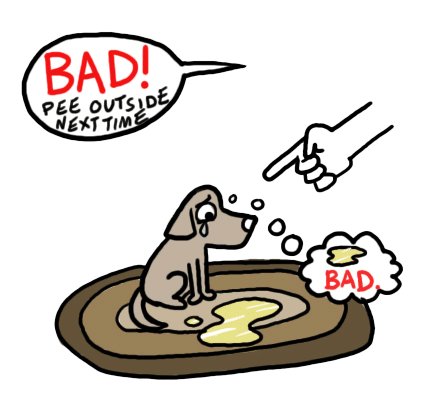
Simple enough right? Let’s think of a person who is trying to train their pet dog. The owner wants the dog to sit down on his command. So every time the owner says ‘sit’ and the dog sits down, the owner gives the dog a treat. The owner has just positively reinforced the good behavior and will encourage the dog to continue to sit on command in the future.
Every time someone walks past the front of the house, the dog starts barking aggressively and is annoying the rest of the neighborhood. To train the dog to not do this, every time the dog barks inappropriately, the owner will spray the dog in the face with water, which the dog absolutely hates. The owner has negatively reinforced the bad behavior to discourage the dog from doing it in the future.
So by rewarding good deeds and punishing bad deeds the dog will learn how to behave appropriately in the future. (This is known as ‘classical conditioning’ and is often explained as ‘Pavlov’s dogs’ after the experiments the Russian physiologist Ivan Pavlov conducted on his own dogs.) Both the dog and the owner are pleased with the outcome. Everyone’s happy.
Now let’s throw a spanner in the works and use random reinforcement examples in the dog’s training. When the dog sits down after the owner commands to do so, sometimes the owner will give him a treat and sometimes the owner will squirt water in the dogs face.
Same deal with the barking problem. When the dog starts barking at people walking past, the owner might come out and spray water in the dogs face, or he might run out and give the dog a treat.
What is this going to do to the dog? Well it’s going to stress the dog out to its limits, the dog won’t be able to tell what’s right and what’s wrong, and will probably develop anxiety problems around the owner.
This is random reinforcement at work here, because the owner is randomly responding to the dog’s behavior with a positive or negative response. The dog will be unable to operate effectively because it’s so confused by the responses from its owner.
So how does random reinforcement affect traders?
You have what you believe to be, an awesome trading system that produces the best Forex signals. You’ve back tested it and the results are great. You have even demo traded the system for a while and demonstrated positive results. So you’ve decide it is time to start trading with your live account. You open the account, deposit your capital and begin placing live trades, following your trade rules and never deviating from your trading plan.
5 trades later and you still haven’t had a successful trade. You can’t understand what went wrong and you start questioning the trading system and your approach with the markets.
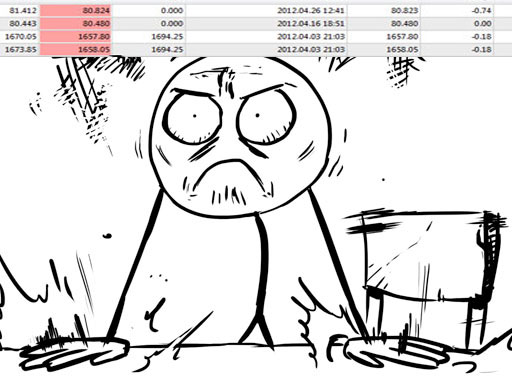
The market has negatively rewarded you for your good behavior. You’ve stuck with your trading plan and been immensely disciplined, but the market slaps you in the face for it. No-one enjoys this experience. Yet every trader experiences it.
Born out of frustration you take an impulsive high risk position that is completely against everything you’ve written in your trading plan. But to your surprise the trade is successful and hits the desired profit target. You try the same technique again and for a second time the trade hits profit. The market has positively rewarded you for your bad behavior.
Through random reinforcement, the market has re-conditioned the way you approach trading by distracting you away from your original trading plan and you’ve allowed yourself to be manipulated into an impulsive, knee-jerk, high risk, revenge based trading approach. Do you see the problem here? The cat is most definitely out of the bag!
Dealing with the dangers

As a trader, you must be able to put up the psychological barrier, defend your mental integrity and understand that you may get a slap in the face for doing the right thing. Hey, you may even get multiple slaps in the face for doing the right thing (the losing streak – believe us – it will happen). As long as you’re following your trading rules then you’re doing the right thing. Consistent and disciplined execution of your trading system is the goal.
A good trade is a trade where you planned your trade, traded your plan and managed your risk. Those are all elements you can control.
Even if the market offers the most perfect trade set-up you’ve ever seen and you execute the trade according to your plan there is still no guarantee that the trade is going to work out in your favor. Regardless of the outcome it is still a good trade if you planned your trade, traded your plan and managed your risk.
A bad trade on the other hand is where you don’t follow your rules and take trades against your better judgement. Or in many cases using no-judgement whatsoever! This is always going to be a bad trade even if it does work out in your favor.
How to stay on track/focused
It is common for a trader to ‘tweak’ a trading system’s rules on the fly to try and get rid of losses completely. It’s a version of ‘curve-fitting’ and what you end up with is a trading system that is completely different to what you started with, losing all the original integrity, logic and have expectations of the Forex market that are unrealistic. This constant tweaking will leave the trader chasing his own tail and eventually abandoning the system completely.
One critical trait that you must learn to have as a trader is being able to deal with a loss. Losses are an everyday part of trading, and yeah you are going to have to learn to deal with losing streaks too. Every trader has ‘clusters’ of both losses and winners in their trading results.
So how can we overcome the challenge of random reinforcement and maintain our mental and trade-plan integrity?
The best way to overcome the psychological beating from random reinforcement is to use positive money management with your trading system. Positive money management means that you will always aim for more than what you initially risk on a trade.
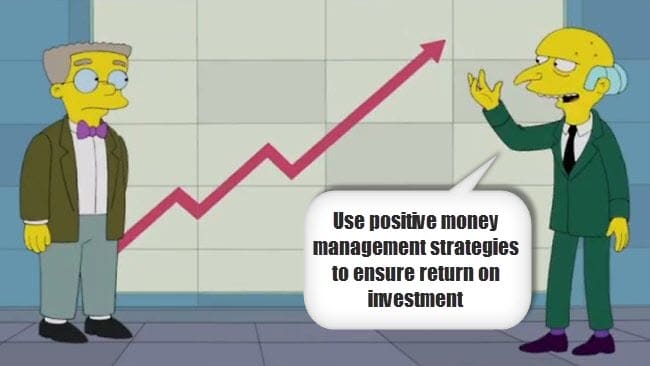
We generally recommend traders start by aiming for a risk/reward ratio of 1:3, this means if they risk $200 on a trade, the goal is to return $600. This type of positive money management will make sure your winning trades greatly outperform your losing trades. So, even if you suffer a losing streak you are only going to need 1 or 2 winning trades to completely make up for your losses and get you back in front of your equity curve.
Have a look at a trade I personally took this week…
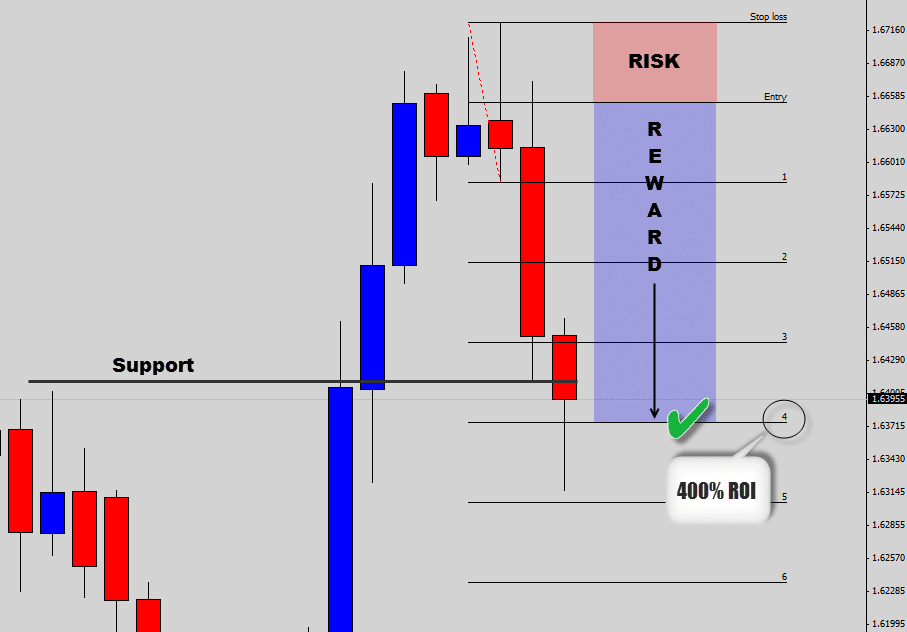
Before I took this trade, I first looked to see if this trade had the potential to at least move to 1:3 risk/reward, which as I mentioned, is the minimum I look for in a trade’s potential return. The market had plenty of room to move down before running into the next key support level so I set my trade up.
The trade moved down and closed aggressively on support so I anticipated that the support level would break. The next trading day support did break and I was going for the 1:6, but the market started rejecting lower prices, and since it was a Friday I decided to quit while I was ahead and take 1:4 risk/reward while it was on the table.
Within two days I got 400% return on my investment, and this trade only took 10 mins of this time to setup. Even if I did have two, or even three losing trades this week, this one trade would have cleaned up my losses and put me back in front. The power of positive geared money management.
Even some of the best traders have an average stop out rate below 50%. In a recent book I read, the trader admitted he lost on 14 out of 15 trades. It was the 15th trade which was successful and made all the difference.
Obviously this trader would have been using some very high risk to reward ratios. With a 1:3 risk/reward ratio in your money management plan you only need to be profitable on 33% of your trade to make money consistently. Only 25% of your trades need to be successful to break even.
Many novice traders will be horrified at the thought of only being right in 1 out of 3, or 1 out of 4 trades. They’ve been through classical conditioning from childhood that you need to be scoring 8 or 9 or 10 out of 10 in any test to be successful in life. Whereas a good experienced trader takes comfort in only having to be profitable 1 out of 3 times. This removes a lot of undue stress and pressure and the ‘need to be right’. (See that classical conditioning coming out to play again?)
If you’re using a proven trading system like price action trading, then a 33% win rate is very achievable, and some good trades can even return 1:6. In contrast that means for every winning trade, you can negate 6 losses. This should inspire you not horrify you!
Conclusion
It’s crucially important that as a trader you understand that you will not always be rewarded with profits for your good behavior in the market. Yes, you might see that perfect setup, everything is lining up perfectly and you can’t see any reason why the trade won’t work out. But we know due to the markets extremely dynamic behavior the trade can be wiped out in an instant. Once the trigger is pulled and the trade is live: anything can happen. You have no control over what the market will do.
It may only take one bad news release to stop out your perfect trade, and you may feel you’ve been punished for doing the right then but you must learn to accept the markets random nature. You will experiences losses from time to time but losses can be eliminated.
You’ve heard of the saying ‘don’t put all your eggs in one basket’, well don’t put too much importance on a single trade; every trade has the potential to lose. The outcome of an individual trade is entirely random.
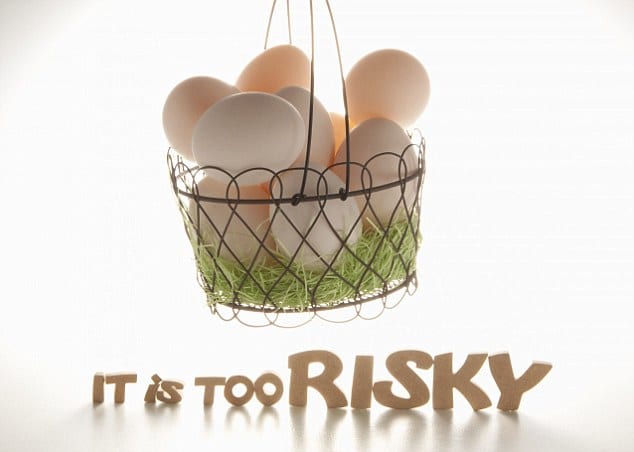
It’s only over a series of trades that your trading edge will shine through. Always use proper money management with each trade and make sure that the money management is consistent with each setup you take.
Being consistent is a sign of excellent self-control and is a very rewarding feeling within itself. Take your reward from having executed your trading system consistently and with discipline.
It’s important to learn how to trade Forex with a solid trading system. We price action strategies that really give a profitable edge in the market, and only trade when the odds are in our favor to help minimize your risk.
If you are struggling to find a proven trading strategy which can really give you the edge in the markets then you may be interested in checking out price action trading.
This form of trading provides a very logical approach to the market, is uncomplicated and very easy to learn. We have traded long enough to know that there is no real Holy Grail of trading, nevertheless by combining positive money management with price action Forex trading strategies, we believe we have found the closest thing possible.

Amir
one of the best articles I’ve ever read. Mark Douglas’s material of course but you explained it very nicely.
thanks a lot man
AKIM
wooooow the psychology here is on another level .i believe this has solved my emotions thanks a lot D
Brian
I can’t believe that I finally found a trader who explained issues I’ve experienced in my first months of trading and how I can fix these problems in terms a simple beginner can understand. Now I’m ready to develope my strategy and I’m confident I will become a successful trader. Thank you very much for helping us Dale Woods and I look forward to learning more from your experiences. I have been trading with Nadex is this a platform you would recommend?
Replying to: Brian
Dale WoodsAuthor
Hi Brain. I stick to Forex mostly. Nothing wrong with Nadex, but I don’t know it as well. The S&P and Dow I trade sometimes.